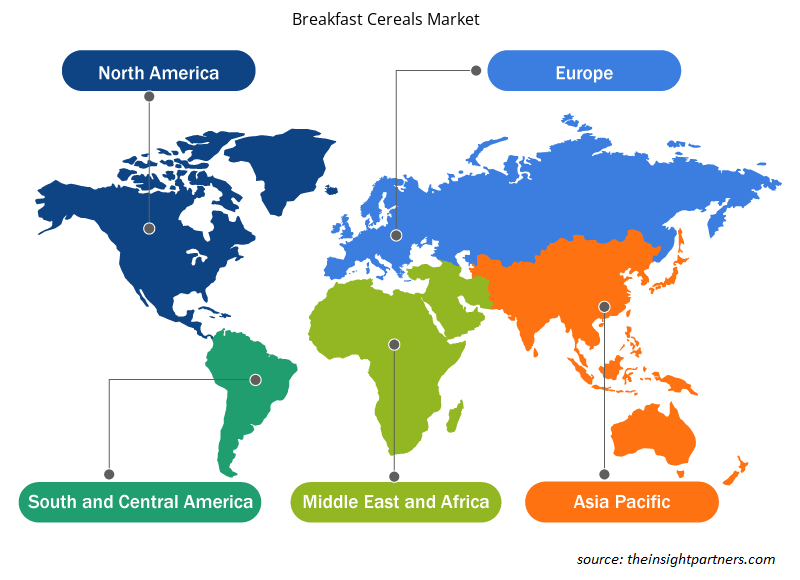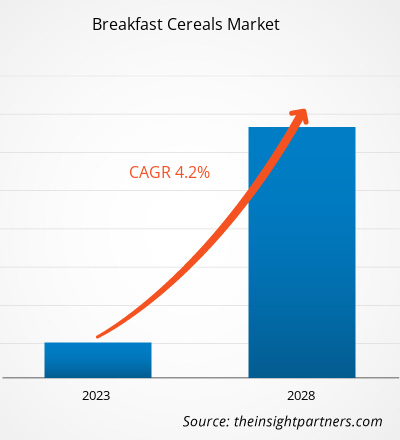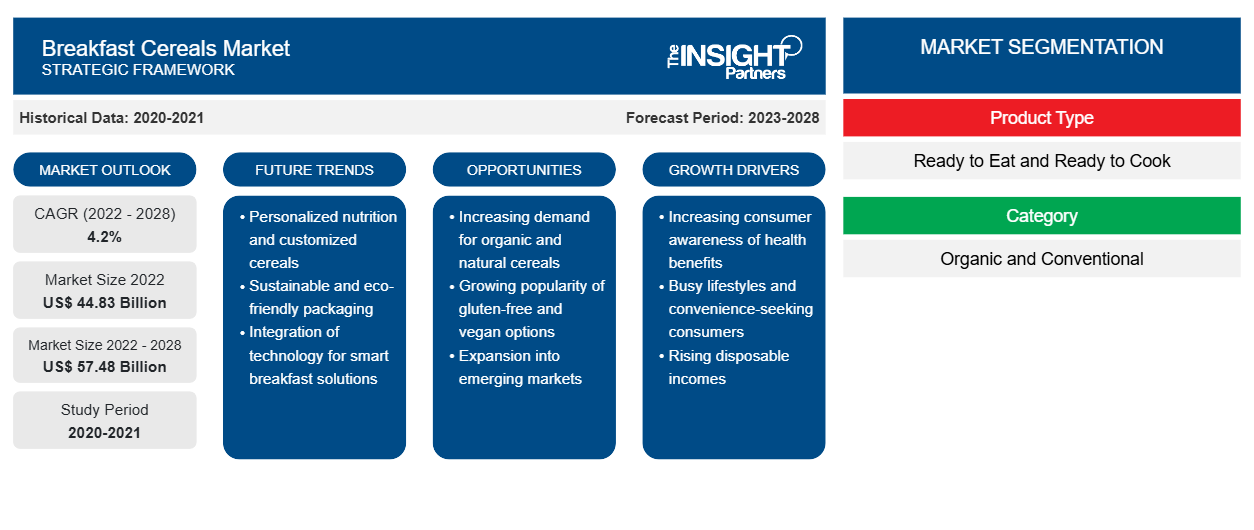Se proyecta que el mercado de cereales para el desayuno alcance los 57.482,17 millones de dólares en 2028, frente a los 44.831,48 millones de dólares en 2022. Se espera que crezca a una CAGR del 4,2 % durante el periodo 2022-2028.
El crecimiento del mercado se atribuye a la creciente preferencia de los consumidores por los alimentos preparados. En la actualidad, las personas tienen diferentes estilos de vida y valores sociales, lo que está impulsando la demanda de alimentos preparados. La tecnología digital que les permite hacer compras más rápidas ha aumentado su dependencia de las comidas preparadas. Estos productos están disponibles en diversas variedades y formas, como comidas para microondas, comidas para llevar, fideos instantáneos y otros tipos de comidas, lo que ha aumentado la disponibilidad de alimentos en el Reino Unido. El aumento del consumo de alimentos preparados ha llevado a los consumidores a comprar más comidas preparadas en la región. Sin embargo, debido a los confinamientos provocados por el brote de COVID-19, los consumidores han recurrido a cocinar en casa, lo que ha obstaculizado el mercado en cierta medida.
En 2021, América del Norte tuvo la participación clave del mercado mundial de cereales para el desayuno . Sin embargo, se estima que Asia Pacífico registrará la CAGR más alta en el mercado durante el período de pronóstico. El mercado en Asia Pacífico está segmentado en China, India, Japón, Corea del Sur y Australia. Los países de APAC, como Corea del Sur, China y Japón, se encuentran entre los principales mercados de alimentos y bebidas. La región también alberga numerosos fabricantes de cereales para el desayuno, que están creciendo debido al aumento de la demanda interna de bebidas envasadas. La creciente producción de bebidas en Asia Pacífico y la creciente preferencia por los alimentos listos para comer contribuirían al crecimiento del mercado en la región durante el período de pronóstico.
Personalice este informe según sus necesidades
Obtendrá personalización en cualquier informe, sin cargo, incluidas partes de este informe o análisis a nivel de país, paquete de datos de Excel, así como también grandes ofertas y descuentos para empresas emergentes y universidades.
-
Obtenga las principales tendencias clave del mercado de este informe.Esta muestra GRATUITA incluirá análisis de datos, desde tendencias del mercado hasta estimaciones y pronósticos.
Impacto de la pandemia de COVID-19 en el mercado de cereales para el desayuno
La pandemia de COVID-19 afectó significativamente al sector manufacturero en términos de eficiencia operativa, debido a los cierres prolongados en diferentes regiones, el cierre de unidades de fabricación, las restricciones a los viajes, al comercio internacional y a la cadena de suministro, y la escasez en el suministro de materias primas, lo que finalmente obstaculizó el mercado de cereales para el desayuno. La interrupción de la industria de alimentos y bebidas debido a la desaceleración económica causada por el brote también obstaculizó el crecimiento del mercado. Sin embargo, las empresas se han recuperado, ya que las limitaciones impuestas anteriormente se están suavizando en varios países.
Además, la introducción de las vacunas contra la COVID-19 por parte de los gobiernos de diferentes países ha aliviado aún más la situación, lo que ha provocado un aumento de las actividades comerciales en todo el mundo. Además, los gobiernos de diferentes países están planeando desarrollar infraestructuras modernas y tecnológicamente avanzadas para mitigar los impactos económicos de la pandemia. Durante el confinamiento, los consumidores compraron muchos alimentos y bebidas envasados a la vez en lugar de artículos de servicio de alimentos. Por lo tanto, a pesar de los impactos negativos de la pandemia de COVID-19, se espera que el mercado de cereales para el desayuno crezca significativamente en los próximos años.
Perspectivas de mercado
Creciente consumo de productos listos para consumir
Los productos alimenticios listos para consumir se han convertido en una de las pocas industrias que han experimentado un aumento de la demanda durante la pandemia de COVID-19. Con los países en cuarentena y la mayoría de las personas trabajando desde casa, el consumo de productos alimenticios listos para consumir se ha disparado. Los consumidores jóvenes gastan la mayor parte de sus ingresos en productos alimenticios listos para consumir, lo que los convierte en el principal objetivo de estos productos. Por lo tanto, el aumento de la demanda y el consumo de alimentos listos para consumir está impulsando el mercado de los cereales para el desayuno.
Perspectivas de la categoría
Según la categoría, el tamaño del mercado mundial de cereales para el desayuno se segmenta en orgánico y convencional. En 2021, el segmento convencional representó una mayor participación de mercado. Sin embargo, se espera que el segmento orgánico aumente a una CAGR más alta durante el período de pronóstico. Los consumidores se han vuelto más conscientes de la importancia de un sistema inmunológico fuerte y un estilo de vida saludable, lo que resulta en una preferencia por los alimentos orgánicos y naturales. Se espera que el cambio de mentalidad continúe impulsando el mercado de alimentos orgánicos durante el período de pronóstico. Los productos alimenticios orgánicos se preparan sin conservantes y no contienen químicos sintéticos. Por lo tanto, las personas están aceptando productos alimenticios orgánicos en su dieta, lo que ayudará a que el mercado crezca en el período de pronóstico.
Las empresas que operan en el mercado de los cereales para el desayuno son The Kellogg Company, WEETABIX, Bob's Red Mill Natural Foods, General Mills Inc., Nestlé SA, Nature's Path Foods, The Quaker Oats Company, Carman's Fine Foods Pty Ltd., Calbee, Inc. y Guilin Seamild Foods Co. Ltd. Estas empresas ofrecen una amplia gama de productos para el mercado y están presentes en las regiones en desarrollo, lo que ofrece oportunidades lucrativas para el mercado. Los actores del mercado están desarrollando productos innovadores y de alta calidad para satisfacer los requisitos de los clientes.
Perspectivas regionales del mercado de cereales para el desayuno
Los analistas de Insight Partners explicaron en detalle las tendencias y los factores regionales que influyen en el mercado de cereales para el desayuno durante el período de pronóstico. Esta sección también analiza los segmentos y la geografía del mercado de cereales para el desayuno en América del Norte, Europa, Asia Pacífico, Oriente Medio y África, y América del Sur y Central.

- Obtenga datos regionales específicos para el mercado de cereales para el desayuno
Alcance del informe sobre el mercado de cereales para el desayuno
| Atributo del informe | Detalles |
|---|---|
| Tamaño del mercado en 2022 | US$ 44.83 mil millones |
| Tamaño del mercado en 2028 | US$ 57,48 mil millones |
| CAGR global (2022-2028) | 4,2% |
| Datos históricos | 2020-2021 |
| Período de pronóstico | 2023-2028 |
| Segmentos cubiertos |
Por tipo de producto
|
| Regiones y países cubiertos |
América del norte
|
| Líderes del mercado y perfiles de empresas clave |
|
Densidad de actores del mercado de cereales para el desayuno: comprensión de su impacto en la dinámica empresarial
El mercado de cereales para el desayuno está creciendo rápidamente, impulsado por la creciente demanda de los usuarios finales debido a factores como la evolución de las preferencias de los consumidores, los avances tecnológicos y una mayor conciencia de los beneficios del producto. A medida que aumenta la demanda, las empresas amplían sus ofertas, innovan para satisfacer las necesidades de los consumidores y aprovechan las tendencias emergentes, lo que impulsa aún más el crecimiento del mercado.
La densidad de actores del mercado se refiere a la distribución de las empresas o firmas que operan dentro de un mercado o industria en particular. Indica cuántos competidores (actores del mercado) están presentes en un espacio de mercado determinado en relación con su tamaño o valor total de mercado.
Las principales empresas que operan en el mercado de cereales para el desayuno son:
- La empresa Kellogg
- Bix dulce
- Alimentos naturales de Bob's Red Mill
- Compañía: General Mills Inc.
- Nestlé SA
Descargo de responsabilidad : Las empresas enumeradas anteriormente no están clasificadas en ningún orden particular.

- Obtenga una descripción general de los principales actores clave del mercado de cereales para el desayuno
Informe Destacado
- Tendencias progresivas de la industria en el mercado de cereales para el desayuno que ayudarán a los actores a desarrollar estrategias efectivas a largo plazo
- Estrategias de crecimiento empresarial adoptadas por los mercados desarrollados y en desarrollo
- Análisis cuantitativo del mercado de cereales para el desayuno de 2020 a 2028
- Estimación de la demanda mundial de cereales para el desayuno
- Análisis de las cinco fuerzas de Porter para ilustrar la eficacia de los compradores y proveedores que operan en la industria
- Avances recientes para comprender el escenario competitivo del mercado
- Tendencias y perspectivas del mercado y factores que impulsan y restringen el crecimiento del mercado de cereales para el desayuno
- Asistencia en el proceso de toma de decisiones destacando las estrategias de mercado que sustentan el interés comercial, lo que conduce al crecimiento del mercado.
- El tamaño del mercado de cereales para el desayuno en varios nodos
- Descripción detallada y segmentación del mercado, así como la dinámica de la industria de los cereales para el desayuno.
- Tamaño del mercado de cereales para el desayuno en diversas regiones con prometedoras oportunidades de crecimiento
El "Análisis del mercado mundial de cereales para el desayuno hasta 2028" es un estudio especializado y profundo de la industria de productos químicos y materiales con un enfoque especial en el análisis de tendencias del mercado mundial de cereales para el desayuno. El informe tiene como objetivo proporcionar una descripción general del mercado con una segmentación detallada del mercado.
El mercado de cereales para el desayuno se analiza en función del material, la aplicación y la geografía. Según el tipo de producto, el mercado se segmenta en listo para comer y listo para cocinar. Según la categoría, el mercado se segmenta en orgánico y convencional. Según el tipo, el mercado se segmenta en bajo en azúcar y regular. Según el canal de distribución, el mercado se segmenta en supermercados e hipermercados, tiendas de conveniencia, venta minorista en línea y otros. Por geografía, el mercado se segmenta ampliamente en América del Norte, Europa, Asia Pacífico (APAC), Medio Oriente y África (MEA), y América del Sur y Central.
Perfiles de empresas
- La empresa Kellogg
- Bix dulce
- Alimentos naturales de Bob's Red Mill
- Compañía: General Mills Inc.
- Nestlé SA
- Alimentos del Camino de la Naturaleza
- La empresa Quaker Oats
- Alimentos finos de Carman Pty Ltd.
- Compañía Calbee, Inc.
- Compañía de alimentos marinos Guilin Ltd.
- Análisis histórico (2 años), año base, pronóstico (7 años) con CAGR
- Análisis PEST y FODA
- Tamaño del mercado, valor/volumen: global, regional y nacional
- Industria y panorama competitivo
- Conjunto de datos de Excel
Informes recientes
Testimonios
Razón para comprar
- Toma de decisiones informada
- Comprensión de la dinámica del mercado
- Análisis competitivo
- Información sobre clientes
- Pronósticos del mercado
- Mitigación de riesgos
- Planificación estratégica
- Justificación de la inversión
- Identificación de mercados emergentes
- Mejora de las estrategias de marketing
- Impulso de la eficiencia operativa
- Alineación con las tendencias regulatorias























 Obtenga una muestra gratuita para - Mercado de cereales para el desayuno
Obtenga una muestra gratuita para - Mercado de cereales para el desayuno